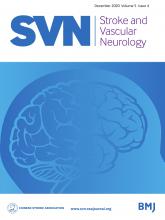Article Figures & Data
Tables
- Table 1
Baseline characteristics of patients who commenced head positioning within 4.5 hours of acute ischaemic stroke onset with initial National Institute of Health Stroke Scale (NIHSS) score ≥7
Baseline characteristics Lying flat
N=432Sitting up
N=435P value Age (years) 73.1 (13.3) 72.3 (13.5) 0.35 Male 230 (53.2%) 233 (53.6%) 0.92 Region, n (%) 0.08 Australia and UK 294 (68.1) 272 (62.5) China and Taiwan 91 (21.1) 107 (24.6) India and Sri Lanka 13 (3.0) 7 (1.6) South America 34 (7.9) 49 (11.3) Hypertension, n (%) 288 (67.1) 265 (60.9) 0.06 Previous stroke, n (%) 89 (20.6) 103 (23.7) 0.28 Atrial fibrillation, n (%) 95 (22.2) 94 (21.8) 0.86 Heart failure, n (%) 36 (8.5) 34 (7.9) 0.77 Diabetes mellitus, n (%) 86 (20.0) 73 (16.8) 0.23 Current smoker, n (%) 60 (14.2) 60 (14.0) 0.91 Aspirin use, n (%) 141 (32.7) 154 (35.4) 0.40 Anticoagulant use, n (%) 53 (12.3) 47 (10.9) 0.50 AIS category, n (%) 0.58 Large vessel 133 (30.8) 134 (30.8) Cardioembolic 110 (25.5) 101 (23.2) Lacunar 59 (13.7) 52 (12.0) Other 130 (30.1) 148 (34.0) NIHSS at admission 13.0 (9.0 to 18.0) 12.0 (9.0 to 18.0) 0.34 mRS, n (%) 0.73 0 (no symptoms) 251 (58.5) 246 (56.8) 1 (no significant disability) 73 (17.0) 73 (16.9) 2 (slight disability) 40 (9.3) 47 (10.9) 3 (moderate disability) 41 (9.6) 42 (9.7) 4 (moderate/severe disability) 22 (5.1) 19 (4.4) 5 (severe disability) 2 (0.5) 6 (1.4) Data are n (%), mean (SD) and median (IQR).
AIS, acute ischaemic stroke; mRS, modified Rankin scale.
- Table 2
90-day outcomes by baseline neurological severity
Outcome* Lying flat versus sitting up OR (95% CI) P value aOR (95% CI) P value NIHSS <7 Ordinal mRS 1.07 (0.83 to 1.37) 0.62 1.03 (0.80 to 1.33) 0.73 Binary mRS 3–6 26.6% versus 26.2% 1.02 (0.72 to 1.45) 0.89 0.93 (0.63 to 1.37) 0.70 Death 3.9% versus 3.2% 1.31 (0.65 to 2.66) 0.46 Did not converge† Cardiovascular SAEs* 7.3% versus 7.2% 1.03 (0.62 to 1.72) 0.90 1.05 (0.62 to 1.78) 0.85 NIHSS≥7 Ordinal mRS 0.94 (0.71 to 1.26) 0.69 0.92 (0.67 to 1.25)‡ 0.59 Binary mRS 3–6 58.7% versus 62.2% 0.86 (0.67 to 1.15) 0.31 0.74 (0.52 to 1.04) 0.08 Death 13.6% versus 15.4% 0.91 (0.59 to 1.41) 0.67 0.80 (0.51 to 1.27) 0.34 Cardiovascular SAEs* 16.0% versus 12.2% 1.31 (0.87 to 1.99) 0.20 1.21 (0.79 to 1.86) 0.37 NIHSS ≥10 Ordinal mRS 0.87 (0.64 to 1.19) 0.38 0.80 (0.58 to 1.10) 0.16 Binary mRS 3–6 68.1% versus 69.6% 0.89 (0.61 to 1.30) 0.55 0.77 (0.49 to 1.19) 0.24 Death 17.2% versus 20.5% 0.85 (0.52 to 1.38) 0.50 0.76 (0.46 to 1.24) 0.27 Cardiovascular SAEs* 17.9% versus 15.4% 1.16 (0.73 to 1.83) 0.54 1.06 (0.66 to 1.70) 0.81 NIHSS ≥14 Ordinal mRS 0.83 (0.56 to 1.27) 0.36 0.82 (0.54 to 1.24) 0.34 Binary mRS 3–6 77.3% versus 75.0% 1.13 (0.65 to 1.98) 0.66 1.05 (0.54 to 2.01) 0.89 Death 22.8% versus 27.8% 0.70 (0.42 to 1.19) 0.19 0.72 (0.40 to 1.30) 0.28 Cardiovascular SAEs* 23.5% versus 18.1% 1.29 (0.75 to 2.21) 0.36 1.30 (0.73 to 2.31) 0.38 Adjusted OR (aOR) obtained for further adjusted age, sex, region groups, premorbid grade (0–1 vs 2–5) according to modified Rankin scale (mRS) assessed at baseline, comorbidity of heart disease, stroke or diabetes mellitus and National Institutes of Health Stroke Scale (NIHSS) at baseline as continuous variable.
*Cardiovascular serious adverse events (SAEs) include cerebrovascular events, cardiac events or other vascular events.
†Hierarchical model cannot be converge due to very few cases of death in this subgroup.
‡Hierarchical model only adjusted study design, age, sex, region groups, premorbid grade (0–1 vs 2–5) according to mRS assessed at baseline and comorbidity of heart disease, stroke or diabetes mellitus.
Supplementary Materials
Supplementary data






